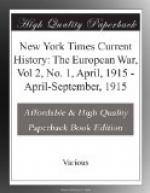The previous dispatches, reviewing the operations of the British regular and territorial troops on the Continent under Field Marshal French’s chief command, appeared in THE NEW YORK TIMES CURRENT HISTORY of Jan. 23, 1915, bringing the account of operations to Nov. 20, 1914. The official dispatch to Earl Kitchener presented below records the bitter experiences of the Winter in the trenches from the last week of November until Feb. 2, 1915.
The following dispatch was received on Feb. 12, 1915, from the Field Marshal Commanding in Chief, the British Army in the Field.
To the Secretary of State for War, War Office, London, S.W.
General Headquarters,
Feb. 2, 1915.
My Lord: I have the honor to forward a further report on the operations of the army under my command.
1. In the period under review the salient feature was the presence of his Majesty the King in the field. His Majesty arrived at Headquarters on Nov. 30 and left on Dec. 5.
At a time when the strength and endurance of the troops had been tried to the utmost throughout the long and arduous battle of Ypres-Armentieres the presence of his Majesty in their midst was of the greatest possible help and encouragement.
His Majesty visited all parts of the extensive area of operations and held numerous inspections of the troops behind the line of trenches.
On Nov. 16 Lieutenant his Royal Highness the Prince of Wales, K.G., Grenadier Guards, joined my staff as aide de camp.
2. Since the date of my last report the operations of the army under my command have been subject almost entirely to the limitations of weather.
History teaches us that the course of campaigns in Europe, which have been actively prosecuted during the months of December and January, have been largely influenced by weather conditions. It should, however, be thoroughly understood throughout the country that the most recent development of armaments and the latest methods of conducting warfare have added greatly to the difficulties and drawbacks of a vigorous Winter campaign.
To cause anything more than a waste of ammunition long-range artillery fire requires constant and accurate observation; but this most necessary condition is rendered impossible of attainment in the midst of continual fog and mist.
Again, armies have now grown accustomed to rely largely on aircraft reconnoissance for accurate information of the enemy, but the effective performance of this service is materially influenced by wind and weather.
The deadly accuracy, range, and quick-firing capabilities of the modern rifle and machine gun require that a fire-swept zone be crossed in the shortest possible space of time by attacking troops. But if men are detained under the enemy’s fire by the difficulty of emerging from a water-logged trench, and by the necessity of passing over ground knee-deep in holding mud and slush, such attacks become practically prohibitive owing to the losses they entail.




